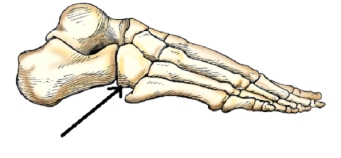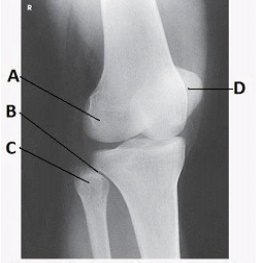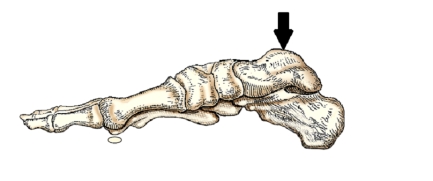A) Perpendicular to the IR
B) Parallel to the IR
C) At a 15- to 20-degree oblique position (laterally)
D) At a 15- to 20-degree oblique position (medially)
Correct Answer

verified
Correct Answer
verified
Multiple Choice
The bone identified by the arrow in this figure is the: 
A) tibia.
B) cuboid.
C) talus.
D) navicular.
Correct Answer

verified
Correct Answer
verified
Multiple Choice
The central ray is directed to which of the following for an AP or AP axial projection of the foot?
A) Head of the second metatarsal
B) Head of the third metatarsal
C) Base of the third metatarsal
D) Base of the fourth metatarsal
Correct Answer

verified
Correct Answer
verified
Multiple Choice
What type of joint is the ankle mortise?
A) Synovial-gliding
B) Synovial-hinge
C) Synovial-ellipsoidal
D) Synovial-ball and socket
Correct Answer

verified
Correct Answer
verified
Multiple Choice
What is the central-ray angle for a PA projection of the patella?
A) 0 degrees
B) 5 degrees cephalad
C) 10 degrees cephalad
D) 5 to 15 degrees cephalad
Correct Answer

verified
Correct Answer
verified
Multiple Choice
To demonstrate the ankle mortise,the leg and foot should be rotated medially how many degrees?
A) 10
B) 25
C) 45
D) 15 to 20
Correct Answer

verified
Correct Answer
verified
Multiple Choice
The only ball-and-socket joint in the foot is the:
A) ankle mortise.
B) tarsometatarsal.
C) calcaneocuboid.
D) talocalcaneonavicular.
Correct Answer

verified
Correct Answer
verified
Multiple Choice
Which projections of the ankle are performed on a patient following an inversion or eversion injury?
A) AP and lateral
B) AP and both obliques
C) AP stress studies
D) AP,lateral,and both obliques
Correct Answer

verified
Correct Answer
verified
Multiple Choice
Which of the following is the essential lateral projection of the calcaneus?
A) Lateral (lateromedial)
B) Lateral (mediolateral)
C) Lateromedial oblique
D) Lateromedial oblique,weight-bearing
Correct Answer

verified
Correct Answer
verified
Multiple Choice
Where is the central ray directed for an AP projection of the knee?
A) inch above the patellar base
B) inch above the patellar apex
C) inch below the patellar base
D) inch below the patellar apex
Correct Answer

verified
Correct Answer
verified
Multiple Choice
Where is the central ray directed for an AP projection of knees,weight-bearing?
A) inch below the apices of the patellae
B) 1 inch below the apices of the patellae
C) 1inches below the apices of the patellae
D) 2 inches below the apices of the patellae
Correct Answer

verified
Correct Answer
verified
Multiple Choice
For an AP oblique projection of the foot in either medial or lateral rotation,the plantar surface of the foot should form an angle of:
A) 15 degrees.
B) 30 degrees.
C) 45 degrees.
D) 60 degrees.
Correct Answer

verified
Correct Answer
verified
Multiple Choice
Posteriorly,the femoral condyles are separated by a deep depression called the:
A) popliteal surface.
B) intercondylar eminence.
C) patellar surface.
D) intercondylar fossa.
Correct Answer

verified
Correct Answer
verified
Multiple Choice
What anatomy is labeled with the letter B in the image below? 
A) Lateral femoral condyle
B) Lateral tibial condyle
C) Proximal tibiofibular joint
D) Tibial tuberosity
Correct Answer

verified
Correct Answer
verified
Multiple Choice
The central-ray angle for AP oblique projections of the knee is:
A) 0 degrees.
B) 5 degrees caudad.
C) 7 degrees cephalad.
D) variable,depending on the ASIS-to-tabletop distance.
Correct Answer

verified
Correct Answer
verified
Multiple Choice
Which ankle projection will clearly demonstrate the ankle mortise in profile?
A) AP
B) AP oblique,15- to 20-degree internal rotation
C) AP oblique,45-degree internal rotation
D) AP oblique,45-degree external rotation
Correct Answer

verified
Correct Answer
verified
Multiple Choice
Where is the central ray directed for the tangential projection (Settegast method) of the patella?
A) Through the patellofemoral joint space
B) To the anterior aspect of the patella
C) At the level of the femoral condyles
D) To the apex of the patella
Correct Answer

verified
Correct Answer
verified
Multiple Choice
What is the central-ray angle for a lateral projection of the patella?
A) 0 degrees
B) 5 degrees cephalad
C) 7 degrees cephalad
D) 10 degrees cephalad
Correct Answer

verified
Correct Answer
verified
Multiple Choice
The central-ray angulation for the AP ankle projection is:
A) 0 degrees.
B) 5 degrees caudad.
C) 10 degrees caudad.
D) 15 to 20 degrees caudad.
Correct Answer

verified
Correct Answer
verified
Multiple Choice
The bone of the foot indicated by the arrow in this figure is the: 
A) navicular.
B) talus.
C) calcaneus.
D) medial cuneiform.
Correct Answer

verified
Correct Answer
verified
Showing 61 - 80 of 154
Related Exams